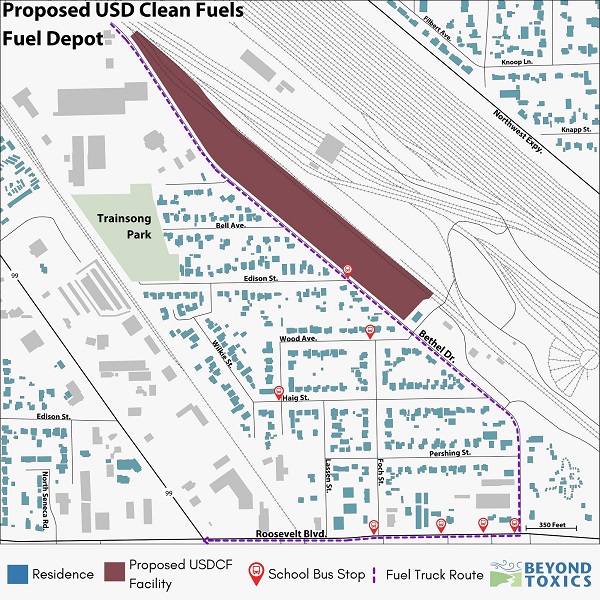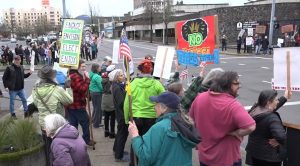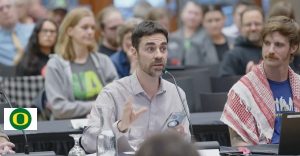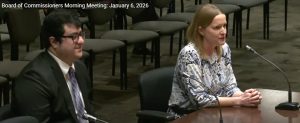Neighbors ask for evacuation plan as city takes 2nd look at fuel transloading facility
6 min read
Eugene’s City Council hears the latest about a proposed fuel transloading station, and Councilor Greg Evans asks: Does the city have an evacuation plan for nearby neighbors? On Oct. 28:
[00:00:13] Sarah Medary (Eugene city manager): I thought I could take an opportunity to give you an update and just talk a little bit about the USD Eugene Clean Fuels LLC project that’s been proposed out in the Bethel area. So they’re proposing to construct a clean fuels transloading facility on existing Union Pacific Railroad yard in Eugene, Oregon land they would lease from Union Pacific.
[00:00:36] The facility will be operated up to 24 hours per day, seven days per week, with approximately 70% of truck trips anticipated between the hours of 6 p.m. to 6 a.m. to avoid high-volume traffic times.
[00:00:49] Development of the facility would add three railroad tracks, two truck loading spots to transload clean advanced biofuels (which is renewable diesel, ethanol, and sustainable aviation fuels) directly from railcars into trucks for more efficient delivery to local retailers than the current supply chain.
[00:01:06] The person online today from the company described it essentially as a large gas station without underground tanks.
[00:01:14] So what they had applied for was a zone verification. And a zone verification itself does not allow or deny a particular use of a property. It simply evaluates whether a proposed use is permitted outright and then would only require building permits or whether additional land use applications are required and/or if special standards must be met before the use is approved.
[00:01:37] We issued a zone verification saying it was an allowable use. We may have made the exact right decision, but I want to make sure we’ve made the exact right decision, and the process allows for us to withdraw that and reconsider and that’s what we’ve done. We have 90 days to do that.
[00:01:56] This is land that is inside the urban growth boundary, outside the city, so it’s, technically all of those lands fall to Lane County. We’ve had an agreement since 1987 that the city reviews and does the land use work on all of those properties. And we do that applying an urban transition code that was voted in by the county. So it’s the county’s code that we’re kind of administering. So there’s some interesting complications with railroad right-of-way being considered unzoned and what can be a use there, what can be done there, and what can’t be. So that’s why we’re going to take a little bit more time.
[00:02:36] Mayor Lucy Vinis: It just feels as if we have these two big entities, a big company and the railroad, and they are independent and they’re making independent decisions and the well-being of the city of Eugene is sort of not factoring into it. And so I really appreciate all of the effort to sort of find those places in which we might be able to assure safety and maybe a shifting in how this project goes forward. It is really interesting to think about. They’ve done some market analysis and decided they need this facility in this place at this volume, and we have no idea what that really is.
[00:03:12] Councilor Mike Clark: JH Baxter was primarily a regulatory failure in our community. There were agencies with regulatory authority to make sure that people around them were safe and it didn’t work. So whether or not we have an overlay zone or don’t, or what point in the future that we do, I want to make sure that this time we know who has primary regulatory authority for the safety, safe operation of such a site if it gets built and some way that we have regular communication or some way that we have regular contact to be able to predict or to try and minimize any potential issues that may come along so I will look forward to your communication on that.
[00:03:58] Councilor Randy Groves: I share a lot of Councilor Clark’s concerns about this, understanding where this is and knowing that this facility is going to have thousands of gallons of highly volatile low-flashpoint fuel that puts off flammable vapors at a very low temperature. So it’s always going to be a hazard and I look at the proximity to the neighborhood, that does concern me.
[00:04:20] To answer part of your question, Councilor Clark, the Federal Railroad Administration has a lot of authority over this, but they are understaffed. And the Federal Railroad Authority or Administration is a subset of the federal Department of Transportation. And I know this because I’ve dealt with them before.
[00:04:37] My big question is, what authority do we have over Bethel Drive, which is a city street, and the access point in and out? Based on what I know, that’s where I think we have most of our teeth. And so, how do we control Bethel Drive as an unimproved street? I don’t know that the base is substantial to hold up to 40 semi, tractor-trailer rigs coming through there day in and out. And I’m just curious what authority we have over our city street.
[00:05:10] Councilor Greg Evans: The mayor and (Councilor) Lyndsie (Leech) and I were at a community meeting about a week and a half ago about this particular situation, and Councilor Groves is right. Going back to 1862 and 1864 in the Lincoln administration, the railroad acts were passed and that gave the railroads 5.2 million square miles of right-of-way that cannot be touched by government regulations, so they can move whatever they want there.
[00:05:44] So a couple of questions come to mind off of this. One of them is coming from that meeting and that is: Is there an evacuation plan for the neighborhood should something go completely off (for lack of a better term) off the rails? It’s what happened in Ohio in, you know, my home state with Norfolk Southern and they had a big spill and, you know, there’s still people that are arguing about that particular situation.
[00:06:14] So what responsibility would either (USD) Clean Fuels or the Union Pacific bear for making sure that the residents across the street are safe? There’s also the people who are in that industrial park to the north, closer to Highway 99.
[00:06:34] And if you drive down Bethel Drive, you know that it can barely hold onto a regular 2,000-pound car, let alone, you know, thousands of pounds of trucks with flammable liquids going through there 24 hours a day. Or what we were told was, ‘Oh, they would only be running between six at night and six in the morning.’
[00:07:03] Forty trucks up and down there. And then, where do they let out at? Is it Roosevelt? Is it Highway 99? Exactly where are those trucks going to be going in the community and what areas are they going to be servicing? What businesses are they going to specifically be servicing? They have different fuels that they’re going to be transporting, so some of it is airplane fuel, some of it may be gasoline, some of it may be other fuels…
[00:07:31] If they’re going to be moving this cargo up and down Bethel Drive, could we or would we require them to be able to reinforce that road or rebuild that road? Because structurally, that road is not going to be able to handle that kind of traffic. And I’m no expert on this, but it doesn’t take a rocket scientist to figure out that Bethel Drive is a two-lane road that’s unimproved, that has no drainage, no sidewalks, nothing. I go down that road all the time. It’s my shortcut going home. So it’s problematic from several standpoints, plus the public safety standpoint.
[00:08:16] John Q: Staff reviews the application, councilors ask about the city’s legal authority, and neighbors want an evacuation plan.
Image courtesy Beyond Toxics.






